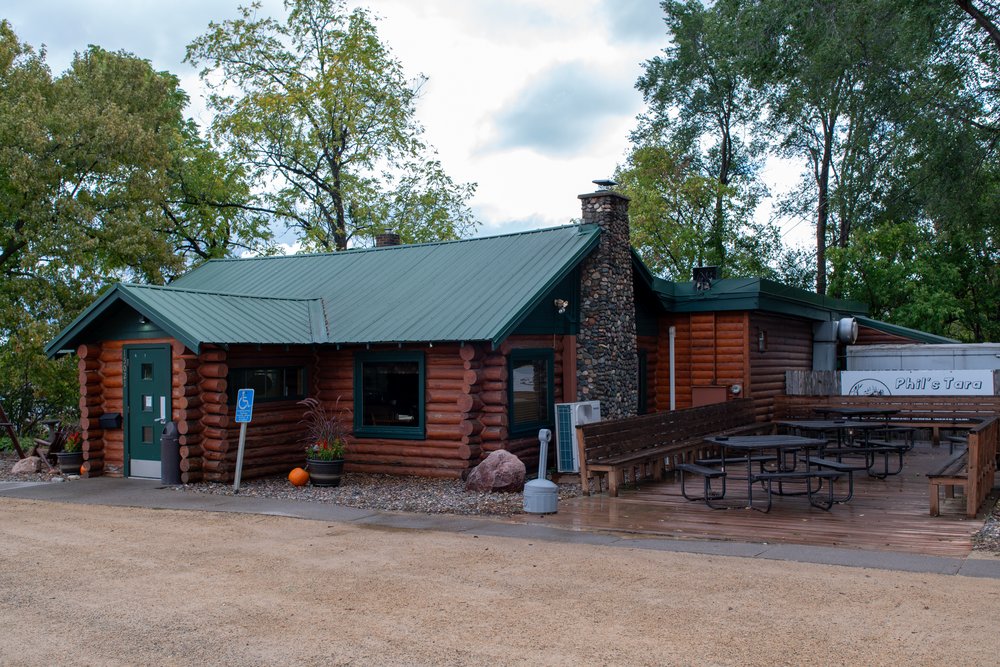Log Cabin Restaurant
Gerald R. (Whitey) Lynch and his brother Eugene were natives of Oak Park, a village located at the southern edge of Stillwater. In 1929 they established Lynch’s Chicken Shack on the site of the present Log Cabin. There is little record of this early business, but when the shack burned in May 1932, Gerald Lynch—and possibly Eugene—immediately rebuilt and within about six months reopened a new business called the Log Cabin. The location along what was then known as Highway 45 was part of a popular route linking the Twin Cities and St. Croix Valley towns. Highway 45 was paved by 1924 as part of the state trunk highway system. By 1934 it was known as Highway 36. In the late 1950s the roadway was reconstructed at a higher grade, and the old road became a frontage road.
The Log Cabin served as a popular roadhouse or, as it was later called, a nightclub. Although the business opened near the end of Prohibition, illegal liquor was initially offered, perhaps in the basement, and anecdotal accounts recorded on recent menus and repeated in local newspaper articles note the Log Cabin’s role in the informal network of gangster stops during the 1930s when St. Paul enjoyed a national reputation for crime.
In February 1933, in anticipation of the end of Prohibition, Gerald and Nettie Lynch obtained a $400 mortgage from the Theo. Hamm Brewing Company. The company’s support for the establishment is evident in a 1939 photograph that shows a large Hamm’s sign mounted on the roof, dwarfing the structure while attracting the attention of motorists.
An account of the likely evening activity at the Log Cabin was provided after a robbery in 1937. The thieves were seeking slot machines but found none. Among stolen equipment and supplies were an “electric phonograph and records, a Bohn refrigerator, 20 cartons of cigarettes, 10 tablecloths, peanuts, gum, and some money.” The Lynch family apparently lived in the rear portion of the building. In 1939, after the building was sold, Lynch built a new residence in Oak Park.
Gerald R. Lynch (1905-unknown), who was apparently known as Whitey, was born to parents of Irish descent. John Lynch, his father, was a railroad section man, and an older brother, James, was a guard at Stillwater State Prison. Although the Chicken Shack was reportedly established in 1929, in 1930 the federal census located Lynch, his wife, and young son living in Detroit in a Polish and Lithuanian neighborhood where he operated a confectionery store. Nettie Lynch (1910-unknown) was of Polish descent and was a Michigan native. By 1932 they were back in Oak Park, where other members of the family lived. According to some accounts, Gerald’s brother Eugene (1900-unknown) was a partner in the Log Cabin. Lynch may have had other employment—he is listed under “Beverages-Retail” in the 1942 Stillwater directory— but Gerald, Nettie, and Eugene are untraceable after 1942.
In 1938, Lynch sold the business to Nick J. Michels, who operated a restaurant and served beer. He retained the Log Cabin name. By 1946, Herbert M. Thiessen purchased the property and changed the business name to Club Tara Hideaway. Herbert and Vi Thiessen also lived in the rear of the restaurant and served meals in the front dining room.
In 1966 Robert W. Browning purchased the property and called it Club Tara. He expanded the menu and converted the former living quarters to a dining room. The business was sold to a group of investors in ca. 1994. They sold it in ca. 1996 to Ryszard Biernacki, a Polish immigrant from Chicago. Biernacki experienced various legal problems during his ownership. There was a short-lived proposal to convert the building to a boarding kennel, but Phil Barbatsis, the present owner, purchased the property in 1997, and completed a restoration of the structure. He operates it as a restaurant known as “Phil’s Tara Hideaway.”
Until the 1950s, the Log Cabin was one of only a few businesses dispersed along Highway 36 between Stillwater, Oak Park, and North St. Paul. During the 1950s and 1960s, new construction along the north and south sides of Highway 36 included apartment buildings, the St. Croix Valley shopping mall, and scattered strip development.
Adapted from a National Register of Historic Places nomination by Carol Zellie

